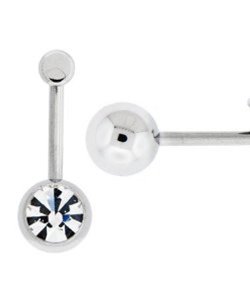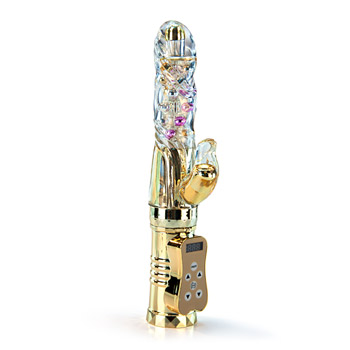"Countless women have come to me saying "I want my clit pierced." When I show them a picture of a clitoris piercing, they shout "Oh no, not THERE!" What they actually want is a clitoral hood, but are not sufficiently acquainted with the territory or terminology to know the difference."
— Elayne Angel, The Piercing Bible
What is it? What's the Difference?
THE CLITORAL HOOD PIERCING:
As was stated before, a lot of people confuse the clitoral piercing with the clitoral hood piercing. Often, someone will ask for a clitoris piercing, THINKING of a clitoral hood piercing.
The clitoral hood piercing is exactly what it sounds like. A piercing of the "hood" of the clitoris. The small bit of tissue above the clitoris. With the clitoral hood piercing, the jewelry will rest next to the clitoris and can provide extra sensation during sex, masturbation, or even during exercise! (I've even been told that sometimes you can wiggle around in your seat and give yourself an orgasm with these.)
This piercing does not go near any major veins or nerves, so when done correctly, will not cause any loss of sensation, but will definitely add to it!
THE CLITORIS PIERCING:
This is a rarely done, often not recommended piercing. This one actually does pierce the clitoris itself. It is highly painful and very difficult to do. Unfortunately, for most women who have their clitoris pierced, an unfortunate side-effect is the loss of sensation because of nerve damage. There are many, many, many nerve endings in the clitoris, and piercing it can, and does, damage them. Only very highly skilled piercers can pull it off and even then there aren't always positive results. Best advice here is don't do it.
Like I said in my previous blog about nipple piercings, choosing the right piercer is the most important step. It may not seem like it, but it is. And this is especially so with an intimate piercing like a clitoral hood. A lot of piercers may not actually be trained in doing such a piercing. In which case, you probably shouldn't volunteer to be their guinea pig.
The first thing I should say is actually ask if intimate piercings are offered at a shop. Some places don't do them either because of lack of training or because of state or city laws. (It is illegal to get your nipples pierced in Antioch, CA. It's considered pornographic and there is a city ordinance against it...I'll give you a second to roll your eyes because I know you're doing that. I did.)
It should also be mentioned that clitoral hood piercings, or genital piercings of any kind, cannot be done on minors. So if you walk into a shop and you're under 18, and the piercer says they will do that to you, walk out. They are breaking the law and probably shouldn't be trusted.
So if you're over 18, and you've established that a shop does intimate piercings, talk to the piercer and look at their portfolio. See how well their past clitoral hood piercings have turned out. (It goes without saying that you should make sure that the piercer knows the difference between a clitoral piercing and piercing the HOOD of the clitoris.)
I cannot stress enough that you should ask as many questions as possible and be sure that the piercer answers them ALL in a professional and competent manner. The clitoral hood is a piercing that has the potential to effect your sexual pleasure. If you feel that the piercer doesn't have enough experience or cannot answer your questions, begin your search anew. A good piercer will be able to answer your questions and maybe even have a sort of consultation with you about whether or not the piercing is a good choice for your body. The piercer may need to examine the tissue of the hood to avoid puncturing any veins or nerves. They may need to tug on it, or move it around in some way. It is important for accurate placement of the jewelry. They will be touching your genitals. Make sure you are okay with this before going to a shop.
Also, and this is IMPORTANT, if you ask your piercer how they do the procedure, and they say "With forceps" LEAVE!! Clamping with forceps endangers the clitoris. It also causes unnecessary extra pain and rarely, if ever, results in proper placement. Standard procedure is to use a receiving tube.
It also goes without saying that you should be comfortable with the piercer too. You have the right to feel comfortable around this person and should expect them to be professional. Since this is such an intimate piercing, you should be able to talk to them without it feeling like you're being sexually harassed in any way. You have the right to call off the piercing if you feel the piercer has crossed a line or is behaving unprofessionally.
As with many piercings, the anticipation of pain can be worse than the actual stick of the needle. Every body is different, and most people instinctively slam their thighs together at the mere mention of genital piercings.
The good news is, clitoral hood piercings are generally not as painful as you might think. The tissue may be sensitive, but it is thinner than the earlobe so the pain is similar to that.
Even if you have a high tolerance for pain (I know I do) you might still be a little startled by the stick of the needle when the piercing is done. Even if you are, try to hold still. A jump or lurch of your body makes it a little more difficult.
A good piercer, however, will anticipate the possibility of a jumper and be able to accommodate. Keep in mind that it is a common response and try to keep your legs open so the piercer can put in the jewelry.
There are two types of clitoral hood piercings. Vertical and horizontal. The more common one is the vertical. Usually the initial jewelry for one of these is a straight or curved barbell ranging in size from 3/8 to 1/2 inch depending on your body type. The common gauge size is 14 or 12. NO LARGER than 10.
Standard placement of the vertical clitoral hood piercing (VCH) is at the apex (deepest part) of the clitoral hood, along the midline. It looks as though it passes through the whole length of tissue, but only a small amount of tissue is pierced and rests against the clitoris (which is a great benefit. Imagine. An orgasm just about any time you want, anywhere you want, with a built-in stimulator!)
With a clitoral hood piercing, you should be able to comfortably put on your underwear and pants with no issues. You might be a little sensitive afterward, but that is normal with fresh piercings. If you feel it is too intense, you could switch the jewelry to a smaller size (this is not a common problem) or take it out entirely. If you must change the size or take out the jewelry, be sure to do it AFTER it has healed to avoid infection.
Common healing time for the (vertical) clitoral hood piercing is 4-8 weeks.
I always believe that the highest-quality jewelry should be used for piercings in general, but because of the sensitive nature of this piercing, I'll stress even more how important it is to shell out the extra cash it will take for high-quality metals.
Implant-grade titanium or surgical steel is best. Be sure that it has a mirror-finish. Your piercer should be able to provide this for you. (Don't go to a piercer that allows you to bring your own jewelry.) Some metals may look smooth, but if they have not been polished to a mirror-finish, they could have small notches or grooves that can grab the tissue and irritate it. Usually a shop will have its own jewelry for initial piercings.
I also highly recommend internally-threaded jewelry. This means that the bar of the barbell will be "female" (hollow at the ends) and the ball will be "male" (with a little screw attached). Internally-threaded barbells are smooth compared to externally-threaded ones, which are rough on each end, and will do less damage to the tissue sliding in.
Do not use acrylic plastic, as it is too porous and not good for healing piercings at all. Body-safe bioplast is a plastic that is inert enough to be used in the body and can be autoclaved to a certain degree. Check with your piercer to see of bioplast is good for you.
The vertical clitoral hood piercing has a relatively short healing time of about 4-8 weeks. Much shorter than the nipples which is a full 9 months!
Be sure to keep it clean. When cleaning, you can clear away any residual puss (Ew...I know, I know, but it must be said) with a regular saline solution. The same kind you would use on contact lenses. While bathing or showering, be sure to use mild, unscented soaps.
The VCH piercing is not placed near any major nerves, so there should be no basis for loss of sensation of the piercing was done properly.
You can engage in normal physical activity after having a VCH done, though you should refrain from activities like bike or horseback riding for the first couple of weeks. With those two exceptions, you should be able to engage in regular exercise without much discomfort. You might not even notice it's there while working out. However, you might notice it and, in fact, enjoy the new sensations it gives you *wink*.
When your piercing is healed, you may change out the jewelry to a different style. Try experimenting with different ball sizes or switch from a curved barbell to a straight one. You may get different sensations with different pieces.
Urinating is a common concern for people who have newly-pierced genitals. It should not be a problem as long as it is your own. I know this sounds gross, but the regular passage of urine over the piercing actually will minimize crusting. It can sting a little after the first few days, so be sure to drink plenty of WATER. Don't drink any juices such as cranberry or orange juices that will make urine acidic. You can actually pour cool water over your piercing as you pee to help clean it off. Plus, it just feels good.
If you are the type that shaves down there, shaving before going to the piercing shop is a good idea. But afterward it may get a little tricky. It may look a little weird, but it is wise to avoid shaving the area near the piercing for a few weeks while it heals.
And this is probably a no-brainer but ALWAYS wear clean underwear!





I love mine! It really isn't too bad, pain-wise. Keep in mind that every anatomy is different. I went in to get a horizontal hood piercing, but my body isn't shaped right for that kind of piercing. Your piercer should be able to tell you if you have the right anatomy for a certain piercing, which is another reason to shop around and find an experienced professional who you trust.
If I remember correctly my piercer also told me to avoid intercourse for the first 6-8 weeks (healing time), and obviously you want to avoid oral sex while healing to keep the area clean and avoid bacterial infection.
The sensation is pretty great, when you first get the piercing you can feel it just walking around. I've noticed that over time I've become less sensitive to it just being there. It's definitely still fun to play with, though
Mine barely hurt after the fris hour of having it and it was the easiest healing experience I've have.
Mine wasn't painful at all after I got mine done. I looove it!